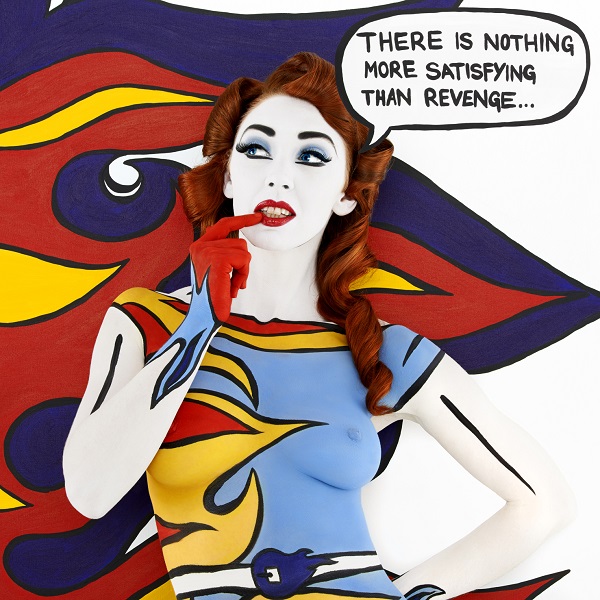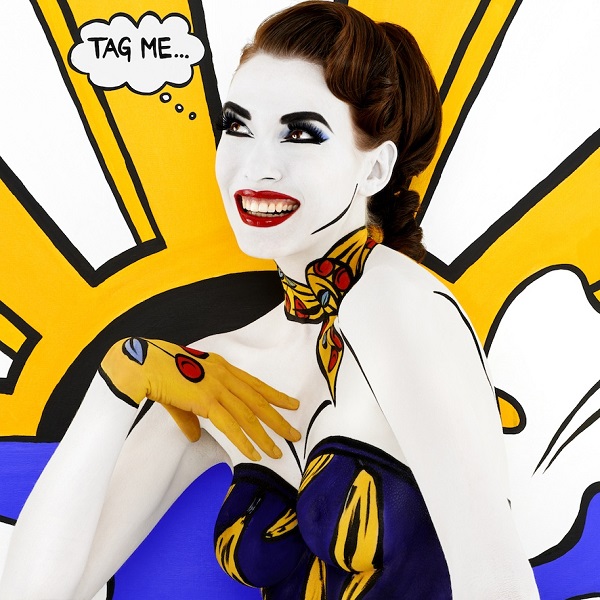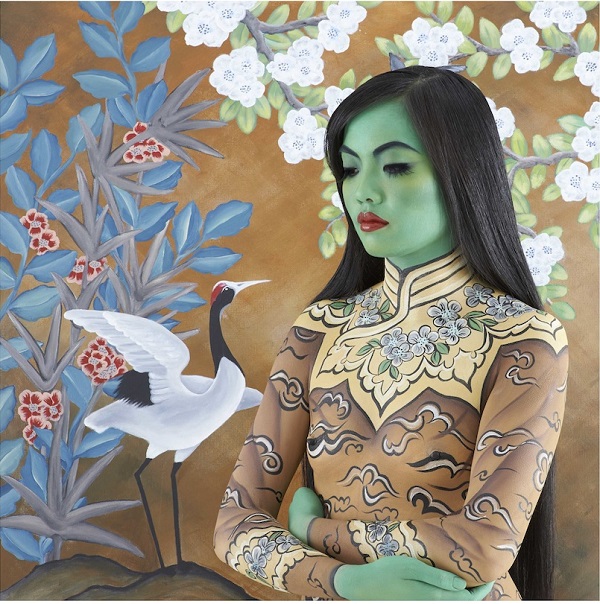Artist of the Week: Body-Painter Emma Hack Unifies Nature with the Human Form

Editorial note: The introduction to this piece has been written collaboratively by editor-in-chief Olga Zapisek and contributor Tara Scarola.
“There is nothing more satisfying than revenge…” No, this isn’t a line from the hit ABC show Revenge, in which the protagonist Emily Thorne (born Amanda Clarke) seeks retribution for her father’s murder, but rather a cartoon-style thought bubble that sits atop a red-haired superwoman dressed in colors of blue, red and yellow, as she bites her fingernail while diverting her eyes sideways, clearly lost in deep contemplation.
Drawing inspiration from pop artist Roy Lichtenstein’s artwork, Australian-based body painter Emma Hack has placed a resilient female amidst the social-media driven world and given her dominance and a positive outlook on life. But what makes her aptly named POP! series truly unique is not the heroic light in which the women are portrayed or the cartoon-nature of it, but rather the fact that the costumes and makeup that they adorn are all carefully painted onto their bodies. The women, smeared in white and vibrantly colored paint from head-to-toe, pose proudly with witty comments that convey relationship and life lessons such as “No use crying over a drop in the ocean…” or “Bored…Paint the town red!” But while these cheeky heroines might very well be the focal point of this collection, most of Hack’s work cleverly deceives the mortal eye by hiding the human form in the background – much like an attempt at playing a game of Where’s Waldo with the viewer. By blending her models into the environment, this self-proclaimed skin illustrator and photographer creates a commentary on Mother Nature, culture and art, resulting in a captivating portrayal of intricate designs and representations of natural life.
Often working long hours, Hack possesses a certain understanding with the models that the finished project might not always be “perfect.” In other words, it may very well possess minor imperfections – something that every person will surely say is what makes each piece distinctive and “alive.” Her artistic process requires a particularly sensitive and steady eye to detail and the need for models to stay still for sometimes over 15 hours, but as Hack herself explains, it is also a type of artwork that allows for quite a bit of fun! The internationally-represented artist says, “There are many challenges. It is a craft that is very difficult, and you must be disciplined with a muse that wants to create something as beautiful as much as you do…”
“I think through art we can inspire people to recognize the beauty surrounding us,” she adds about her collection Birds of Prey. Hack feels nature is important, and her delicate and intricate paintings demonstrate the beautiful combination of flora, fauna, and landscape with human life. “Nature surrounds all cultures and leads their inspirations…therefore, [it] plays a huge part in the environment in which my models are captured,” she says.
Famous for her work on Gotye’s music video for hit-single “Somebody That I Used to Know” (featuring Kimbra) and her Body Crash sculpture, which demonstrates the dangers that come with speedy driving, Hack’s art spans from commercial to personal collections and transcends genres. Unifying nature and the human form, this expressive artist creates unique images that certainly leave a lasting impression in the mind’s eye and push the boundaries of contemporary art.
GALO: Many tones of color are evident in your artwork. Beautiful Women contains images that are gentle and, at times, playful. Overall, the colors appear earthy and pastel, much like the environments they are representing, compared to the bright and bold colors in POP!, reminiscent of cartoons or ’60s pop art (think: Andy Warhol). As an artist, what is the hardest part in transitioning between such varied collections?
Emma Hack: The ’60s reference is Roy Lichtenstein for the POP! collection. To be honest, color is a huge passion of mine. Something that comes easily when choosing how I wish to portray the art as well as the emotion felt when viewing.

“Tag Me” from the POP! series by artist Emma Hack. Photo Credit: Emma Hack.
GALO: Nakedness can often be seen as the ultimate form of freedom, yet the women in your Beautiful Women collection are described as being not yet free. Are the birds or wings, which are added into various images, analogous with the fact that the women are naked, or are they symbolic of a flight that has yet to take place — a flight toward sovereignty, perhaps? How does the addition of the birds or wings relate to your theme?
EH: Nudity is not part of the story for me, to be honest; this is just a means of creating for me and what I do. I believe the bird symbolism within the work offers the discussion that a flight is to take place, to freedom and expression. This collection is based on perceptions of women from different cultures throughout the mid 20th century, before women’s lib and feminism. They are a lead into the feminist discussion of how far have we actually come.

“The Oriental” from the “Beautiful Women” collection by Emma Hack. Photo Credit: Emma Hack.
GALO: You said in an interview with trendspotting.com that you are influenced by nature. How important is nature in Beautiful Women as well as overall in your works? How does the presence of nature affect the image and theme in Beautiful Women?
EH: Nature surrounds all cultures and leads their inspirations for clothing and art as well as how they eat and their survival. It is the most important part of all, and therefore, plays a huge part in the environment in which my models are captured.
